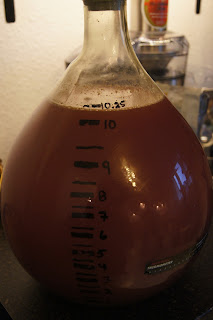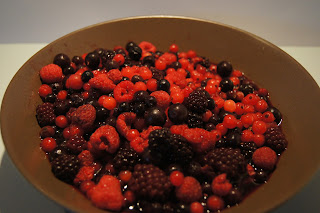Going along with my Berry Beer I thought something like a Hefeweizen would be a nice spring/summer evening sipper. In my scouring of the Home Brew Talk Gluten Free forums I stumbled over Igliashon’s Purple Hefereisen. The uniqueness of the Purple rice is what really intrigued me, so I thought I would adapt it to my ingredients and give it a whirl, and a whirl of a day it was. The brew day went well for the most part right up until I got distracted while making my dinner and grabbed the handle of a pan that had just came out of a 200°C (400°F) oven. After that Mrs. Thirsty reminded me again why I love her and not only finished making dinner and played nurse to yours truly but she also finished up the brew day. What a wonderful woman I tell you. Well, on with the show.
Dunkelrot Kristallreisen
Batch Size: 10.25L Type: Extract / Partial Boil Boil Size: 7.2L Boil Time: 60min
Calculated OG: 1.048 Measured OG: 1.063 Calculated FG: 1.008 Bitterness: 19.1IBUs
Grain Bill
2.00kg Purple Rice (aka Forbidden Rice) – Steeped for an hour
0.25kg Rice Syrup – Boil for 60min
1.00kg Rice Syrup – Boil for 40min
0.35kg Amber Belgian Candy Sugar – Boil for 5min
Hop Schedule
5.00g Tettnang [5.50 %] – First Wort Hop 15min
5.00g Cascade [7.30 %] – Boil 40,0min
5.00g Tettnang [5.50 %] – Boil 20,0min
5.00g Cascade [7.30 %] – Boil 5,0min
5.00g Tettnang [5.50 %] – at Flameout
Miscellaneous
10.00ml Brewferm Beerzym MULTI – Added to steeping water
5.00 g Irish Moss – Boil 10min
50.00 g Malto-Dextrin – Boil 5min
15.00 g Blood Orange Peel – Boil 5min
6.00 g Cracked Coriander – Boil 5min
8.00 g Yeast Nutrient – Added to yeast while rehydrating
1 pkg SafBrew Specialty Ale (DCL/Fermentis #T-58)
So the purpose here, after making a quaffable brew of course, is to make an attempt at playing with the enzyme that I bought a couple months back when I first started this whole brewing hobby. To this end I decided to steep the rice hot water (154-165°F) for about an hour with some of the enzyme and see what happens. In this case, the water turned a beautiful dark purple that is almost black but when I tested a sample with the hydrometer, there was absolutely no sugar converted.
 |
| Beautiful dark purple |
When I go back now and think about this, it’s obvious that there shouldn’t be, because the rice was never brought to a temperature where is would release starch into the water, so the enzyme never had anything to work with. Not a huge problem but a bit of a disappointment that I missed something so fundamental to brewing. I’m going to have to take a look at my plans for future brews and make sure I don’t make the same mistake.
 |
| Another rigged setup to let the water drip from the rice |
The target of this beer when I was building it in Beersmith I decided would be a Dunkelweizen. This is a fruity and spicy wheat beer which dark with a malty richness. Going with the dark purple rice and the Rice Syrup base I thought this was appropriate. The caramelized honey should add a bit of a malty backbone and the IBUs as calculated are a little higher than is acceptable for a Dunkelweizen, but it should be tasty.
So the boil went well, and I put the pot outside to cool. While the wort was cooling, I started prepping dinner. I put a frying pan in the oven at 200°C (400°F) for a steak and then decided to throw some of the rice into a pan. The rice was not quite cooked so I cooked a little bacon up, added some red pepper and the rice and a little water to steam it all together. In the mean time I pulled the pan out of the oven and put in on the stove top. I put a little salt and pepper on the steak and went to grab the frying pan, to move the handle to the side. The searing pain reminded me that the frying pan was just in the oven. I cried out and immediately put my hand under some cold water while Mrs. Thirsty came in to find out the problem.
 |
| Sitting in the carboy, working away. |
From here on out Mrs. Thirsty finished up my dinner for me, searing the steak on each side for 30 seconds then putting the whole pan back in the oven for 5 minutes. After dinner, when the wort cooled, Mrs. Thirsty poured it into the carboy and added bottled water to 10L and then she rehydrated the yeast with 250ml of bottled water and 8g of yeast nutrient and added all of it to the carboy.
The next morning when I looked in on the beer, I could tell the yeast was excited. A thick, purple krausen, had pushed up through the airlock, causing the little red cap to pop off and a little spray of purple to spread around the carboy. I’m thinking next time I need a blow off tube because this happened 4 more times over the next two days. Each time I cleaned the airlock out and refilled it, proving I am just a little insane by repeating the same actions hoping for different results. After a couple days it did slow down and the airlock has stayed clear. I’m going to plan on carbonating this on the low end of the style range and I’m really looking forward to the first taste.
Enjoy!
Photos courtesy of Mrs. Thirsty











